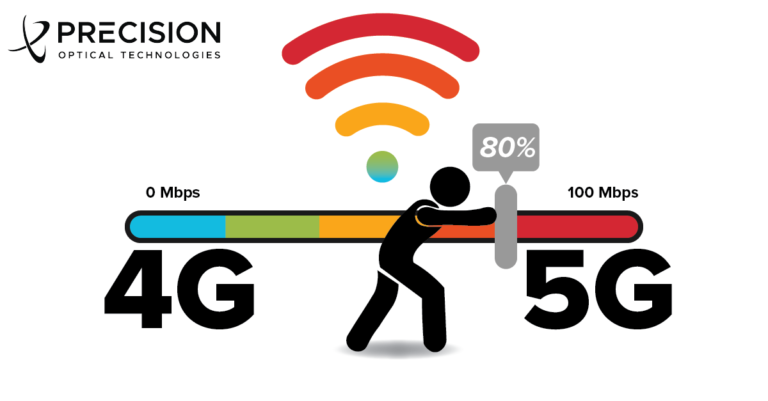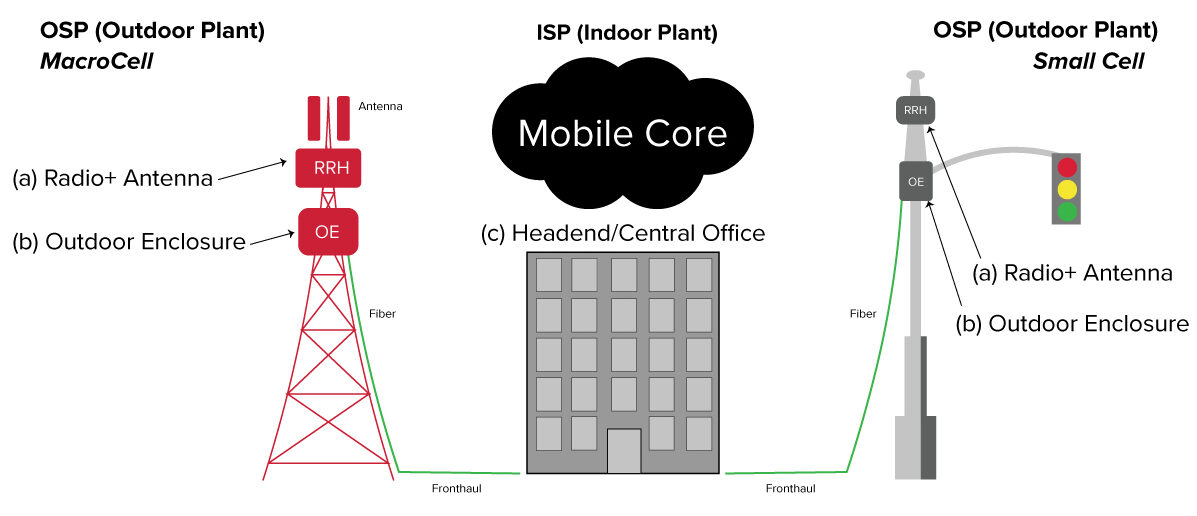
Meeting 5G Expectations with a Complete Layer 1 Solution

Meeting 5G Expectations with a Complete Layer 1 Solution
The 5th Generation Mobile Network (ie. 5G) comes with a lot of promise: higher data rates, ultra low latency, higher reliability, massive network capacity, dense connections and the list goes on. But in practical terms, how does one achieve 5G’s highest potential? What preparation, design, hardware and engineering due diligence must be put in up front to enable a 5G network that truly performs as promised?
The Fronthaul/Backhaul Overhaul
The move from 4G to 5G brings necessary and welcome change when it comes to traditional ways of thinking about Fronthaul & Backhaul architectures. Now looking at transport more as a service (xHaul), members of the Open Radio Access Network (O-RAN) Alliance have brought us one step closer to a “truly open, intelligent, virtualized and fully interoperable RAN.” At the 2021 O-RAN Alliance Plugfest, Precision OT took part in creating a tested and verified 5G xHaul transport solution. Adaptable xHaul configurations are critical to balancing the latency, reliability and throughput demands from the plethora of advanced applications on 5G networks.
Another key component of traditional Fronthaul that’s been updated is CPRI (Common Public Radio Interface). CPRI is an interface that sends data from remote radio units (RRU) to base station units. Making the jump from 4G to 5G networks, we have much larger spectral bands and massive MIMO(multiple input, multiple output) systems. Enhanced CPRI (eCPRI) is a way of splitting up the baseband functions to reduce traffic strain on the fiber. eCPRI will be used to support 5G by enabling increased efficiency and supporting O-RAN. It will provide flexible radio data transmission through a packet based type of fronthaul network, for example IP or Ethernet. For more information on the transition from CPRI to eCPRI click here.
What does Layer 1 of a 5G Network look like?
5G networks use some radio frequencies in a band known as Sub 6 (600MHz – 6GHz, part of which is also used by current 4G LTE) and 5G will also use a higher band of frequencies (24 GHz – 86 GHz). These much higher frequencies bring with them much higher data rates. While some higher band 5G frequencies can carry more data with higher performance – they can’t carry it as far. So, 5G will use a lot of so-called “small cells”. These are smaller versions of the big cellular towers we all know. The Thales Group estimates that 5G will need to support 1 million devices every 0.386 square miles, which means there will be huge demands on bandwidth in high density areas. And where you need bandwidth, you need a complete Layer 1 solution. Layer 1 of a network refers to the physical hardware components of that network which process and transmit digital data from place to place. As you might imagine, a large quantity and variety of hardware, software and engineering know-how goes into Layer 1 and the specifics may vary depending on the particular installation requirements.
Fig. 1 Example Layer 1 5G Network Architecture – Macrocell and Small Cell
Example Layer 1 Solution for a 5G Network
Figure 1 depicts examples of a Macrocell and a Small Cell such as you might find in a 5G network. Macrocell networks provide low-frequency radio coverage for miles by utilizing a high power cell site (which could be on top of a tower as shown or on top of a building, etc…). Small cells utilize smaller, highly directional antennas which often leverage a technique called beamforming to direct coverage to a specific location. Small cells provide high-frequency coverage for shorter distances. Both types of cells may be composed of Outside Plant (OSP) and Inside Plant (ISP) components and require a power source and backhaul (ie. fiber, wire or microwave…) to connect towards the network and mobile core elements.
Outside Plant (OSP)
OSP describes network infrastructure installed external to buildings with some components such as OSP cables generally buried underground or aerial.
a) Remote Radio Head (RRH) + Antenna
The RRH, located just below and/or attached to the antenna contains the analog to digital (ADC) and digital to analog (DAC) conversion and is typically where an optical transceiver(s) would be plugged in. As these are OSP components, they should be Industrial Temperature ( -40C to +85C) or even Hardened Temperature ( -40C to +92C) to sustain harsh environments. Based on the network design requirements of different data rates, distance and fiber availability, the following are examples of transceivers that are typically used in the mobile fronthaul:
- 10G SFP+ DWDM (Tunable or Fixed)
- 25G DWDM (Tunable or Fixed)
- 10G SFP+ Bidirectional (BIDI) or 25G SFP28 BIDI
b) Outdoor Enclosure
Enclosures are used in OSP installations to house components such as a Mux/Demux units and periphery products. The enclosure is a physical chassis that helps protect the inside components from outside elements and could have inside, for example in the case of certain 5G deployments, an OSP DWDM Mux/Demux unit. Precision has a wide range of Mux/Demux units with customizable options such as:
- 4/8/10/12/20/24/40/48 DWDM Channels
- AWG and TFF filter options
- Upgrade/Express/Test Ports
- Multiple Cassette Sizes/Pigtail Lengths
- UPC/APC Connectors
Inside Plant (ISP)
ISP refers to the parts of a communication system installed inside of a building. This building could be called the Headend, or Central Office or it could be inside a home or business (Inside Premises). A 5G ISP deployment may include everything from Mux/Demux units, transceivers, racks, patch panels and cords, to fiber cables and jacks. ISP designs and installations should take into consideration future needs for testing, troubleshooting, documentation and restoration. Configurations differ significantly so a wide variety of component types may come in useful
c) Headend / Central Office
Tying it all Together
Perhaps the most important component in a 5G system is not a particular piece of hardware – it’s the systems engineering knowledge that ensures everything fits and works together efficiently and reliably. Precision OT’s Systems and Field Applications Engineering teams have comprehensive network knowledge, expertise and experience working directly with customers to make sure the end-to-end solution fits their requirements and specifications. Having 1 “owner” for Layer 1 connectivity simplifies supply chain and technical support significantly. Precision OT has a flexible and modular portfolio which can be customized to support your 5G Layer 1 use case in a reliable and cost-efficient way. For all your optical networking needs from transceivers to Mux/Demux and rackmounts, come talk to us!







